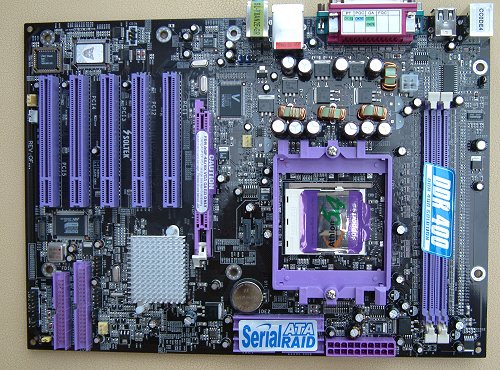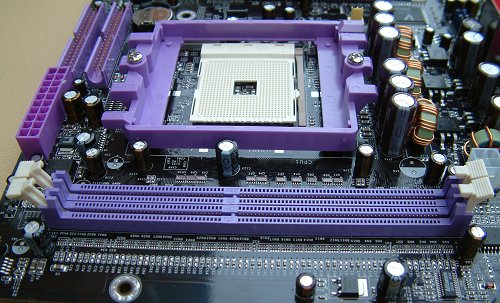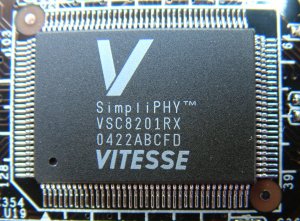|
|
Soltek 8KAN2E-GR nForce3 250Gb S754 Motherboard
[Abstract]
OverclockingWith respect to enthusiasts, one of the nForce3 250Gb's main selling points has been in the supposed ability to lock PCI and AGP buses to user-defined levels. Locking these buses al...
[Content] PCDigitalMobileGame
' technical guru, Ryszard, took a look at look at what makes the nForec3 250 chipset tick in March of this year. I'd recommend perusing his article to gain a better understanding of how and why NVIDIA arrived at nForce3 250.

nForce3 250Gb probably isn't quite as feature-rich as its VIA counterpart, but it does have a space-saving design going for it. Notice that there's no traditional bridge divide on the board. nForce3 250Gb is a single-chip solution which sits just to the left of the AGP port. That leaves motherboard makers the opportunity to use a smaller PCB. Soltek's K8AN2E measures the usual 305mm across but only 220mm in height, 20mm less than most ATX boards.

The narrower width has allowed Soltek, as we look at it, to locate DDR slots in a vertical manner. It makes RAM installation and removal a cinch and eliminates any problems caused by possible interference from extra-long graphics cards. This approach also leads to a generous amount of room around the CPU socket. The mauve-coloured ports are an acquired taste but at least it shows Soltek is thinking of aesthetics as well as performance. Primary and Secondary IDE ports are on the right-hand side of the board, next to the 20-pin main power connector. Just to the left of the CPU retention bracket are 2 RAIDable SATA ports, powered via a controller located directly on the nForce3 250 chip. Soltek could have done with moving them to the right a touch.

A couple of extra SATA ports and a single additional IDE port can only mean one thing - discrete RAID. Promise's PDC20579 supports a total of 4 drives, split equally between SATA and IDE. RAID0, RAID1, RAID0+1, and JBOD (spanning) options are available, much akin to NVIDIA's 2-drive on-chip solution. The difference here is that both SATA and IDE can make up an array. It's easy to use and has worked well for Soltek in the past. nForce3 250 is lacking in on-chip FireWire support and Soltek deems it an unnecessary feature here. Users will have to invest in an additional PCI FireWire card. 5 PCI slots should make expandability no problem at all.

On-chip Gigabit LAN is routed through to the RJ45 connector via VITESSE's transceiver. On-chip support infers no potential bandwidth bottlenecking that arises when Gigabit LAN is run off the PCI Bus. The minimal extra expense of GbE over regular 10/100 LAN makes it a good choice here. It also adds perceived value to the package. Soltek, though, has gone for a low-cost audio CODEC. Realtek's ALC650 is actually a step backwards from its popular ALC655 CODEC that graced many a motherboard last year. I'd take Realtek's own ALC658 any day of the week.

Audio connectivity hasn't been maximised on Soltek's K8AN2E motherboard. We usually expect to see either optical or coaxial S/PDIF inputs and outputs in the I/O section. What compounds the problem is a lack of bundled S/PDIF bracket. This I/O section is pretty indicative of most boards, as there's the usual mix of high-speed ports and older, slower Serial and Parallel connections. Soltek's done a good job with board layout and also included a reasonable feature set.
|
|
|

 Albatron K8X890 Pro II K8T890 Motherboard Review Launched (2005-02-19)
Albatron K8X890 Pro II K8T890 Motherboard Review Launched (2005-02-19) EQS A58XK9-ALF Radeon Xpress 200P motherboard (2005-02-11)
EQS A58XK9-ALF Radeon Xpress 200P motherboard (2005-02-11) ABIT Unleashes Fatal1ty AN8 Motherboard (2005-02-02)
ABIT Unleashes Fatal1ty AN8 Motherboard (2005-02-02) First Tier Motherboard Manufacturers Expect 2005 Growth (2005-01-27)
First Tier Motherboard Manufacturers Expect 2005 Growth (2005-01-27) Biostar I915P-A7 Motherboard (2005-01-06)
Biostar I915P-A7 Motherboard (2005-01-06) EPoX UNLEASHES THE POWERFUL MOTHERBOARD EP-9NPA+ ULTRA (2004-12-29)
EPoX UNLEASHES THE POWERFUL MOTHERBOARD EP-9NPA+ ULTRA (2004-12-29) ELITEGROUP COMPUTER SYSTEMS UK LTD (ECS) Supply the Worlds No 1 Dual Graphic ... (2004-12-29)
ELITEGROUP COMPUTER SYSTEMS UK LTD (ECS) Supply the Worlds No 1 Dual Graphic ... (2004-12-29) ECS Unveils Three NVIDIA nForce4 Series Motherboards (2004-12-29)
ECS Unveils Three NVIDIA nForce4 Series Motherboards (2004-12-29) Soltek Qbic EQ3501-300P Review (2005-01-18)
Soltek Qbic EQ3501-300P Review (2005-01-18) Soltek Qbic EQ3901 Review (2005-01-15)
Soltek Qbic EQ3901 Review (2005-01-15) Soltek SL-K8TPro-939 Review (2004-12-26)
Soltek SL-K8TPro-939 Review (2004-12-26) 





